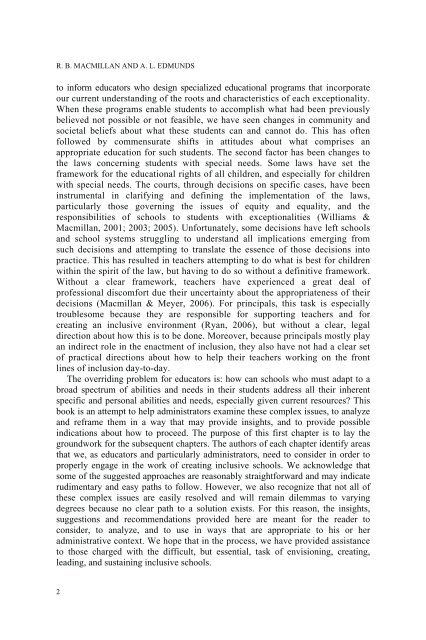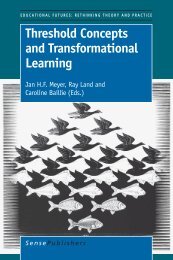Leadership for Inclusion
577-leadership-for-inclusion
577-leadership-for-inclusion
- No tags were found...
Create successful ePaper yourself
Turn your PDF publications into a flip-book with our unique Google optimized e-Paper software.
R. B. MACMILLAN AND A. L. EDMUNDS<br />
to in<strong>for</strong>m educators who design specialized educational programs that incorporate<br />
our current understanding of the roots and characteristics of each exceptionality.<br />
When these programs enable students to accomplish what had been previously<br />
believed not possible or not feasible, we have seen changes in community and<br />
societal beliefs about what these students can and cannot do. This has often<br />
followed by commensurate shifts in attitudes about what comprises an<br />
appropriate education <strong>for</strong> such students. The second factor has been changes to<br />
the laws concerning students with special needs. Some laws have set the<br />
framework <strong>for</strong> the educational rights of all children, and especially <strong>for</strong> children<br />
with special needs. The courts, through decisions on specific cases, have been<br />
instrumental in clarifying and defining the implementation of the laws,<br />
particularly those governing the issues of equity and equality, and the<br />
responsibilities of schools to students with exceptionalities (Williams &<br />
Macmillan, 2001; 2003; 2005). Un<strong>for</strong>tunately, some decisions have left schools<br />
and school systems struggling to understand all implications emerging from<br />
such decisions and attempting to translate the essence of those decisions into<br />
practice. This has resulted in teachers attempting to do what is best <strong>for</strong> children<br />
within the spirit of the law, but having to do so without a definitive framework.<br />
Without a clear framework, teachers have experienced a great deal of<br />
professional discom<strong>for</strong>t due their uncertainty about the appropriateness of their<br />
decisions (Macmillan & Meyer, 2006). For principals, this task is especially<br />
troublesome because they are responsible <strong>for</strong> supporting teachers and <strong>for</strong><br />
creating an inclusive environment (Ryan, 2006), but without a clear, legal<br />
direction about how this is to be done. Moreover, because principals mostly play<br />
an indirect role in the enactment of inclusion, they also have not had a clear set<br />
of practical directions about how to help their teachers working on the front<br />
lines of inclusion day-to-day.<br />
The overriding problem <strong>for</strong> educators is: how can schools who must adapt to a<br />
broad spectrum of abilities and needs in their students address all their inherent<br />
specific and personal abilities and needs, especially given current resources? This<br />
book is an attempt to help administrators examine these complex issues, to analyze<br />
and reframe them in a way that may provide insights, and to provide possible<br />
indications about how to proceed. The purpose of this first chapter is to lay the<br />
groundwork <strong>for</strong> the subsequent chapters. The authors of each chapter identify areas<br />
that we, as educators and particularly administrators, need to consider in order to<br />
properly engage in the work of creating inclusive schools. We acknowledge that<br />
some of the suggested approaches are reasonably straight<strong>for</strong>ward and may indicate<br />
rudimentary and easy paths to follow. However, we also recognize that not all of<br />
these complex issues are easily resolved and will remain dilemmas to varying<br />
degrees because no clear path to a solution exists. For this reason, the insights,<br />
suggestions and recommendations provided here are meant <strong>for</strong> the reader to<br />
consider, to analyze, and to use in ways that are appropriate to his or her<br />
administrative context. We hope that in the process, we have provided assistance<br />
to those charged with the difficult, but essential, task of envisioning, creating,<br />
leading, and sustaining inclusive schools.<br />
2




